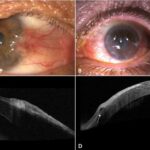Overview

Amplitude of accommodation (AA) which is also known as Accommodative Response is the range of focus from far to near objects that the eye can accommodate. The contraction and relaxation of the ciliary muscle achieve this by changing the shape of the lens, allowing it to focus on near or far objects. The autonomic nervous system controls the process of accommodation by adjusting the tension of the ciliary muscle to achieve the desired focus. A reduction in the amplitude of accommodation can lead to blurred vision, eye strain, and headaches.
It is measured in diopters (D) and the normal range of amplitude of accommodation is around 10-14 diopters. Several factors affect the amplitude of accommodation, including age, refractive error, genetics, medications, and medical conditions such as Down Syndrome. A reduced amplitude of accommodation can lead to presbyopia, accommodative insufficiency, and accommodative spasm.
How to Measure Amplitude of Accommodation
There are several methods to measure the amplitude of accommodation monocularly or binocularly, including the push-up method, push-down method, minus lens method, and dynamic retinoscopy method.
Push-Up Method
In this method, the patient starts by viewing a target at a distance of approximately 40 cm, and then the Doctor slowly moves the target toward the Patient’s eyes along a ruler. The patient is asked to tell when the target object becomes blurred. When it becomes blurred then the target is slowly moved backwards until it becomes clear again. The Doctor measures the distance between the target and the eyes, in meters. Convert this metric measurement into diopters [1/D (distance in meters)] to determine the Amplitude of Accommodation (in Diopters).
Push-Down
The push-down method is the reverse of the push-up method. Involves holding the object closer to the eyes initially, and then moving it away until it becomes blurry.
Minus Lens Method
A phoropter is the best instrument for performing this method. Add minus lenses (in 0.25 D steps) to the patient’s distance refractive correction while reading the best visual acuity line at 40 cm until it becomes blurred. The maximum negative lens that causes sustained blurriness in the eyes added to the distance of testing, 40 cm (in diopters) is the AA.
Dynamic Retinoscopy
During a retinoscopy exam, the subject holds a rod close to their eyes and looks at a target placed at the closest point where they can see it. The examiner then performs dynamic retinoscopy along the horizontal axis and determines the physical position where the light reflex is neutral. Measure this distance and convert it to the amplitude of accommodation (AA) in diopters (D).
Expected Amplitude of Accommodation (Hofstetter’s equation)
After measuring the Amplitude of Accommodation, you compare it with the ‘expected values’ you expect the patient to have depending on their age. This can be done using the Hofstetter’s equation below.
- Minimum AA = 15–0.25 (age in years)
- Average AA = 18.5–0.30 (age in years)
- Maximum AA = 25–0.40 (age in years)
Exercises to Improve Amplitude of Accommodation
Several exercises can help improve the amplitude of accommodation, including:
Near-Far Shifting
This exercise involves looking at an object close to the eyes and then shifting focus to an object far away. Repeat this exercise for 10-15 minutes daily.
Pencil Push-ups
This exercise involves holding a pencil at arm’s length and slowly bringing it closer to the eyes until it becomes blurry, you move it away and start again. Repeat this exercise for 10-15 minutes daily.
Brock String Exercise
It involves using a string with several beads on it and positioning it between the eyes and a distant target. Arrange the beads at different distances from the eyes, with the closest bead just a few inches away and the farthest bead several feet away. The patient is to perform the exercise by focusing on each bead as it moves closer to the eyes and then farther away. This movement of the beads creates a 3D effect that helps the eyes work together to focus on objects at different distances.
Perform the Brock String Exercise at home or under the supervision of a vision therapist. To achieve significant improvements in the amplitude of accommodation, experts recommend performing the exercise for 10-15 minutes daily. It is also essential to maintain proper posture and lighting while performing the exercise to avoid eye strain and fatigue. Watch the video below.
Computer-based Vision Therapy
This exercise involves using computer-based programs designed to improve the amplitude of accommodation. These programs use visual stimuli to train the eyes to focus on near and far objects.
Conclusion
The amplitude of accommodation is an essential aspect of vision that can affect the quality of life. Knowing how to measure it and exercises to improve it can help maintain good eye health and prevent vision problems. If you experience any vision problems, it’s essential to get a comprehensive eye exam to identify any underlying issues and take appropriate measures to address them.
References
- Aboumourad, R., & Anderson, H. A. (2019). Comparison of Dynamic Retinoscopy and Autorefraction for Measurement of Accommodative Amplitude. Optometry and vision science : official publication of the American Academy of Optometry, 96(9), 670–677. https://doi.org/10.1097/OPX.0000000000001423
- León, A., Estrada, J. M., & Rosenfield, M. (2016). Age and the amplitude of accommodation measured using dynamic retinoscopy. Ophthalmic and Physiological Optics, 36(1), 5-12. https://doi.org/10.1111/opo.12244
- https://eyepatient.net/Home/articledetail/amplitude-of-accommodation-test-4663
- Abraham, Lekha Mary DNB; Kuriakose, Thomas DNB, FRCS (Ed); Sivanandam, Viswanathan DROpt; Venkatesan, Nithya Dopt; Thomas, Ravi MD; Muliyil, Jayaprakash MD, Dr.PH (Epid). Amplitude of Accommodation and its Relation to Refractive Errors. Indian Journal of Ophthalmology 53(2):p 105-108, Apr–Jun 2005. | DOI: 10.4103/0301-4738.16173




